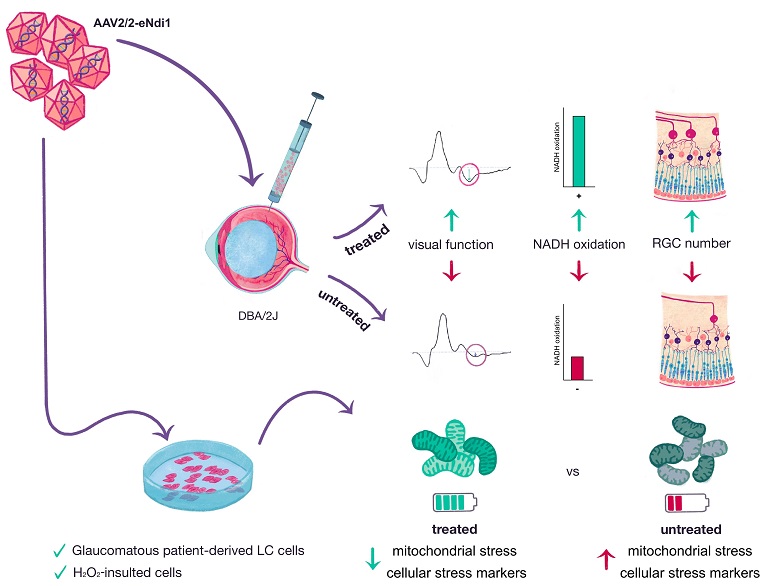Nikhil Prasad Fact checked by:Thailand Medical News Team Sep 17, 2024 7 months, 1 week, 2 days, 20 hours, 42 minutes ago
Glaucoma News: Glaucoma is a leading cause of irreversible blindness affecting millions worldwide. Researchers from Trinity College Dublin, Royal Victoria Eye and Ear Hospital, and the Mater Misericordiae University Hospital in Dublin, Ireland, have made significant strides in developing a novel gene therapy to combat this debilitating disease. The therapy, named AAV-NDI1, was designed to improve mitochondrial function, one of the emerging factors contributing to glaucoma’s progression. This
Glaucoma News report explores the exciting potential of AAV-NDI1 gene therapy, which offers a glimmer of hope for glaucoma patients who don’t respond to current treatments.
 Glaucoma-News-AAV-NDI1-gene-therapy-shows-promise-for-treating-Glaucoma
Glaucoma and Its Global Impact
Glaucoma-News-AAV-NDI1-gene-therapy-shows-promise-for-treating-Glaucoma
Glaucoma and Its Global Impact
Glaucoma affects 70 to 80 million people globally, with around 10% of patients becoming blind as a result. The disease is marked by progressive damage to retinal ganglion cells (RGCs) in the eye, leading to a loss of peripheral vision. Though there are different types of glaucoma, the most common, primary open-angle glaucoma, typically occurs when intraocular pressure (IOP) increases and damages the optic nerve. For many patients, controlling IOP is the only available treatment, using topical medications, laser treatments, or surgery. However, this is not always effective, especially for patients with normal-tension glaucoma, where the IOP isn’t elevated.
Recent studies have highlighted other important contributors to glaucoma, such as mitochondrial dysfunction and oxidative stress. Mitochondria are responsible for generating energy in cells, and when they malfunction, cells can no longer perform vital tasks. In RGCs, mitochondrial dysfunction has been linked to cell death, aggravating vision loss in glaucoma.
The Science Behind AAV-NDI1 Gene Therapy
AAV-NDI1 therapy uses an adeno-associated viral (AAV) vector to deliver the NDI1 gene to the eye. NDI1, derived from yeast, is a nuclear-encoded protein that mimics a component of mitochondrial complex I, an enzyme essential for cellular respiration. The therapy works by restoring mitochondrial function in damaged RGCs, enhancing their ability to produce energy, and reducing harmful reactive oxygen species (ROS), which are responsible for oxidative stress.
In preclinical studies, the research team tested the effectiveness of AAV-NDI1 in both murine models (mice) and human cell models of glaucoma. The key study findings show promising results.
Study Highlights: Protecting Retinal Ganglion Cells
In their research, the team used aged DBA/2J mice, a well-established genetic model for glaucoma, to assess the impact of AAV-NDI1 on RGC survival. The results demonstrated that treated mice experienced a significant reduction in RGC death compared to untreated controls. Specifically, the number of RGCs in AAV-NDI1-treated mice was notably higher (1,552.4 ± 994.0 RGCs/mm²) compared to the control group (1,184.4 ± 978.4 RGCs/mm²), underscoring the therapy
’s ability to protect these vital cells.
Further, the researchers measured photonegative responses (PhNRs), an indicator of RGC function. Mice treated with AAV-NDI1 showed improved PhNRs (6.4 ± 3.3 µV), compared to untreated mice (5.0 ± 3.1 µV). These results suggest that the gene therapy not only preserves the structure of RGCs but also maintains their function, crucial for preventing vision loss.
Human Cell Models Confirm the Benefits
In addition to animal models, the researchers tested AAV-NDI1 on glaucomatous lamina cribrosa (LC) cells from human donors. LC cells play a critical role in supporting RGC axons, which are responsible for transmitting visual signals from the eye to the brain. In glaucomatous cells, mitochondrial function was severely impaired, and the production of ATP, the cell’s energy currency, was diminished.
After treating the glaucomatous LC cells with AAV-NDI1, the study found a marked improvement in mitochondrial function. Basal oxygen consumption rates (OCR) increased significantly in treated cells (136.70 ± 18.63 pmol/min) compared to untreated cells (91.90 ± 17.87 pmol/min), while maximal OCR levels also saw substantial increases. Additionally, ATP production improved in treated cells, showcasing AAV-NDI1’s potential to restore energy balance in damaged cells.
Addressing Oxidative Stress
One of the major complications in glaucoma is oxidative stress, which accelerates the death of RGCs. The study tested AAV-NDI1’s ability to combat oxidative stress in porcine LC cells exposed to hydrogen peroxide (H₂O₂), a compound known to induce oxidative damage. The results were remarkable: the gene therapy significantly reduced ROS levels and mitochondrial stress markers in H₂O₂-insulted cells. Furthermore, cells treated with AAV-NDI1 displayed fewer apoptotic (dying) cells, indicating that the therapy not only protects mitochondrial function but also promotes cell survival.
NADH Oxidation and Mitochondrial Health
The research team also examined the effects of AAV-NDI1 on NADH oxidation, an essential process for energy production. In both the retina and optic nerve of DBA/2J mice, AAV-NDI1-treated tissue showed a marked increase in NADH oxidation rates, a clear indication that the therapy boosts mitochondrial activity. This result is critical, as mitochondrial dysfunction is a key driver of glaucoma-related RGC loss. By enhancing mitochondrial health, AAV-NDI1 helps preserve vision in glaucoma models.
Future Outlook: A Potential Breakthrough in Glaucoma Treatment
The study findings offer strong evidence that AAV-NDI1 therapy could become a viable treatment for glaucoma, particularly for patients who do not respond to traditional IOP-lowering treatments. By directly addressing mitochondrial dysfunction and oxidative stress, this therapy targets the root causes of RGC death, potentially halting or even reversing vision loss.
Despite these promising results, it is important to note that further studies, including human clinical trials, are necessary before AAV-NDI1 can be made widely available. However, this innovative therapy provides a much-needed breakthrough in glaucoma treatment research, particularly as the global burden of glaucoma continues to rise.
Conclusion
In summary, AAV-NDI1 gene therapy represents a groundbreaking approach to treating glaucoma. By restoring mitochondrial function, reducing oxidative stress, and preserving RGCs, the therapy offers new hope for patients suffering from this devastating condition. The potential to protect vision and halt disease progression marks a significant advancement in ophthalmology.
The study findings were published in the peer-reviewed International Journal of Molecular Sciences.
https://www.mdpi.com/1422-0067/25/16/8876
For the latest
Glaucoma News, keep on logging to Thailand Medical News.
Read Also:
https://www.thailandmedical.news/news/glaucoma-news-japanese-study-finds-reduced-levels-of-glutathione-in-glaucoma-patients-suggesting-that-excessive-oxidative-stress-plays-key-role
https://www.thailandmedical.news/news/glaucoma-news-meta-study-finds-that-glaucoma-patients-have-higher-serum-uric-acid-levels
